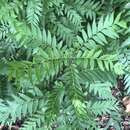en
names in breadcrumbs


Clausena excavata is a species of evergreen shrub that grows 1–2 metres (3 ft 3 in – 6 ft 7 in) tall, in the family Rutaceae, native to Bangladesh, Bhutan, Cambodia, China, India, Indonesia, Laos, Malaysia, Myanmar, Nepal, the Philippines, Taiwan, Thailand, and Vietnam.[2] The plant is commonly by various names, including pink lime-berry, cama, cemama, cemamar, cerek, cerek hitam, kemantu hitam, secerek, semeru, and suntang hitam.[3]
The leaves are used in Southeast Asian cooking, emitting a curry-like smell when crushed.[4] The plant's berries are also edible and have an anise flavour.[4] The plant is astringent, bitter, emmenagogue and considered a tonic for digestive problems.[4]
One of the phytochemicals the plant contains is lichexanthone.[5]
{{cite web}}: CS1 maint: url-status (link) {{cite web}}: CS1 maint: url-status (link) Clausena excavata is a species of evergreen shrub that grows 1–2 metres (3 ft 3 in – 6 ft 7 in) tall, in the family Rutaceae, native to Bangladesh, Bhutan, Cambodia, China, India, Indonesia, Laos, Malaysia, Myanmar, Nepal, the Philippines, Taiwan, Thailand, and Vietnam. The plant is commonly by various names, including pink lime-berry, cama, cemama, cemamar, cerek, cerek hitam, kemantu hitam, secerek, semeru, and suntang hitam.